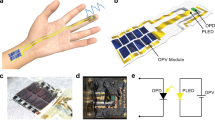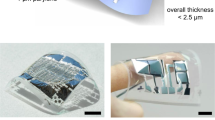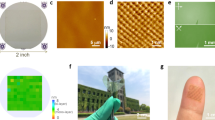Abstract
Next-generation biomedical devices1,2,3,4,5,6,7,8,9 will need to be self-powered and conformable to human skin or other tissue. Such devices would enable the accurate and continuous detection of physiological signals without the need for an external power supply or bulky connecting wires. Self-powering functionality could be provided by flexible photovoltaics that can adhere to moveable and complex three-dimensional biological tissues1,2,3,4 and skin5,6,7,8,9. Ultra-flexible organic power sources10,11,12,13 that can be wrapped around an object have proven mechanical and thermal stability in long-term operation13, making them potentially useful in human-compatible electronics. However, the integration of these power sources with functional electric devices including sensors has not yet been demonstrated because of their unstable output power under mechanical deformation and angular change. Also, it will be necessary to minimize high-temperature and energy-intensive processes10,12 when fabricating an integrated power source and sensor, because such processes can damage the active material of the functional device and deform the few-micrometre-thick polymeric substrates. Here we realize self-powered ultra-flexible electronic devices that can measure biometric signals with very high signal-to-noise ratios when applied to skin or other tissue. We integrated organic electrochemical transistors used as sensors with organic photovoltaic power sources on a one-micrometre-thick ultra-flexible substrate. A high-throughput room-temperature moulding process was used to form nano-grating morphologies (with a periodicity of 760 nanometres) on the charge transporting layers. This substantially increased the efficiency of the organophotovoltaics, giving a high power-conversion efficiency that reached 10.5 per cent and resulted in a high power-per-weight value of 11.46 watts per gram. The organic electrochemical transistors exhibited a transconductance of 0.8 millisiemens and fast responsivity above one kilohertz under physiological conditions, which resulted in a maximum signal-to-noise ratio of 40.02 decibels for cardiac signal detection. Our findings offer a general platform for next-generation self-powered electronics.
This is a preview of subscription content, access via your institution
Access options
Access Nature and 54 other Nature Portfolio journals
Get Nature+, our best-value online-access subscription
$29.99 / 30 days
cancel any time
Subscribe to this journal
Receive 51 print issues and online access
$199.00 per year
only $3.90 per issue
Buy this article
- Purchase on Springer Link
- Instant access to full article PDF
Prices may be subject to local taxes which are calculated during checkout




Similar content being viewed by others
Data availability
The data that support the findings of this study are available from the corresponding authors on reasonable request.
References
Li, Z., Zhu, G., Yang, R., Wang, A. C. & Wang, Z. L. Muscle-driven in vivo nanogenerator. Adv. Mater. 22, 2534–2537 (2010).
Dagdeviren, C. et al. Conformal piezoelectric energy harvesting and storage from motions of the heart, lung, and diaphragm. Proc. Natl Acad. Sci. USA 111, 1927–1932 (2014).
Ho, J. S. et al. Wireless power transfer to deep-tissue microimplants. Proc. Natl Acad. Sci. USA 111, 7974–7979 (2014).
Song, K. et al. Subdermal flexible solar cell arrays for powering medical electronic implants. Adv. Healthc. Mater. 5, 1572–1580 (2016).
Gao, W. et al. Fully integrated wearable sensor arrays for multiplexed in situ perspiration analysis. Nature 529, 509–514 (2016).
Wang, S. et al. Skin electronics from scalable fabrication of an intrinsically stretchable transistor array. Nature 555, 83–88 (2018).
Kim, D.-H. et al. Epidermal electronics. Science 333, 838–843 (2011).
Son, D. et al. Multifunctional wearable devices for diagnosis and therapy of movement disorders. Nat. Nanotechnol. 9, 397–404 (2014).
Lee, J. W. et al. Soft, thin skin-mounted power management systems and their use in wireless thermography. Proc. Natl Acad. Sci. USA 113, 6131–6136 (2016).
Kaltenbrunner, M. et al. Ultrathin and lightweight organic solar cells with high flexibility. Nat. Commun. 3, 770 (2012).
Kaltenbrunner, M. et al. Flexible high power-per-weight perovskite solar cells with chromium oxide-metal contacts for improved stability in air. Nat. Mater. 14, 1032–1039 (2015).
Jinno, H. et al. Stretchable and waterproof elastomer-coated organic photovoltaics for washable electronic textile applications. Nat. Energy 2, 780–785 (2017).
Xu, X., Fukuda, K., Park, S. & Someya, T. Thermally stable, highly efficient, ultraflexible organic photovoltaics. Proc. Natl Acad. Sci. USA 115, 4589–4594 (2018).
Heo, S. W. et al. Cumulative gain in organic solar cells by using multiple optical nanopatterns. J. Mater. Chem. A 5, 10347–10354 (2017).
Bodurov, I., Yovcheva, T. & Sainov, S. Refractive index investigations of nanoparticles dispersed in water. J. Phys. Conf. Ser. 558, 012062 (2014).
Rose, A., Zhu, Z., Madigan, C. F., Swager, T. M. & Bulović, V. Sensitivity gains in chemosensing by lasing action in organic polymers. Nature 434, 876–879 (2005).
Yamagiwa, S., Ishida, M. & Kawano, T. Flexible parylene-film optical waveguide arrays. Appl. Phys. Lett. 107, 083502 (2015).
Munday, J. N. & Atwater, H. A. Large integrated absorption enhancement in plasmonic solar cells by combining metallic gratings and antireflection coatings. Nano Lett. 11, 2195–2201 (2011).
Khodagholy, D. et al. High transconductance organic electrochemical transistors. Nat. Commun. 4, 2133 (2013).
Khodagholy, D. et al. In vivo recordings of brain activity using organic transistors. Nat. Commun. 4, 1575 (2013).
Campana, A., Cramer, T., Simon, D. T., Berggren, M. & Biscarini, F. Electrocardiographic recording with conformable organic electrochemical transistor fabricated on resorbable bioscaffold. Adv. Mater. 26, 3874–3878 (2014).
Rivnay, J. et al. High-performance transistors for bioelectronics through tuning of channel thickness. Sci. Adv. 1, e1400251 (2015).
Lee, W. et al. Transparent, conformable, active multielectrode array using organic electrochemical transistors. Proc. Natl Acad. Sci. USA 114, 10554–10559 (2017).
Northrop, R. B. Analysis and Application of Analog Electronic Circuits to Biomedical Instrumentation (CRC, Boca Raton, 2012).
Ott, H. W. Noise Reduction Techniques in Electronic Systems (Wiley, New York, 1988).
Fuketa, H. et al. 16.4 Energy-autonomous fever alarm armband integrating fully flexible solar cells, piezoelectric speaker, temperature detector, and 12V organic complementary FET circuits. In 2015 IEEE Int. Solid-State Circuits Conf. (ISSCC) Digest of Technical Papers 16.4 1–3 https://doi.org/10.1109/ISSCC.2015.7063043 (IEEE, 2015).
Fedotov, A. A. Selection of parameters of bandpass filtering of the ECG signal for heart rhythm monitoring systems. Biomed. Eng. 50, 114–118 (2016).
Orphanidou, C. Signal Quality Assessment in Physiological Monitoring: State of the Art and Practical Considerations (Springer, Cham, 2017).
Zakhidov, A. A. et al. Orthogonal processing: a new strategy for organic electronics. Chem. Sci. 2, 1178–1182 (2011).
Tomita, H. et al. Visual properties of transgenic rats harboring the channelrhodopsin-2 gene regulated by the Thy-1.2 promoter. PLoS ONE 4, e7679 (2009).
Acknowledgements
We thank Toray Industries, Inc., for supplying the polymer material (PBDTTT-OFT) used in our OPVs, and H. Yawo for supplying the optogenetic rat. This work was financially supported by Japan Science and Technology Agency ACCEL grant number JPMJMI17F1.
Reviewer information
Nature thanks F. Cicoira, D.-H. Kim and K. Leo for their contribution to the peer review of this work.
Author information
Authors and Affiliations
Contributions
S.P. and T.S. conceived and designed the research. S.P. and S.W.H. fabricated 1D double-grating-patterned ultra-flexible OPV devices and performed electrical and optical measurements. S.P., W.L., T.Y. and M.S. fabricated integrated devices, and performed electrical measurements and the demonstration of ECG monitoring. D.I. and D.H. observed cross-sectional SEM and TEM images. Z.J., K.Y. and H.J. helped in data analysis. S.P., K.F., K.T. and T.S. analysed and interpreted the data, and prepared the manuscript with comments from all the co-authors. T.S. supervised the project.
Corresponding authors
Ethics declarations
Competing interests
: The authors declare no competing interests.
Additional information
Publisher’s note: Springer Nature remains neutral with regard to jurisdictional claims in published maps and institutional affiliations.
Supplementary information
Supplementary Information
This file contains Supplementary Tables 1 and 2 and Supplementary Figs. 1–29, Supplementary Video captions and Supplementary References. Full figure captions are provided separately in the Supplementary Information Guide.
Supplementary Information
This file contains the Supplementary Information Guide; which includes the full captions for Supplementary Figs. 1–29.
Video 1
Nano-grating patterned organic photovoltaic devices. Ultra-flexible 1D double-grating-patterned OPVs before delamination from the glass substrate.
Video 2
Self-powered ultra-flexible devices and their ECG signal monitoring. Self-powering integrated electronic device attached to the heart of a rat.
Rights and permissions
About this article
Cite this article
Park, S., Heo, S.W., Lee, W. et al. Self-powered ultra-flexible electronics via nano-grating-patterned organic photovoltaics. Nature 561, 516–521 (2018). https://doi.org/10.1038/s41586-018-0536-x
Received:
Accepted:
Published:
Issue Date:
DOI: https://doi.org/10.1038/s41586-018-0536-x
Keywords
This article is cited by
-
Two way workable microchanneled hydrogel suture to diagnose, treat and monitor the infarcted heart
Nature Communications (2024)
-
Pulse irradiation synthesis of metal chalcogenides on flexible substrates for enhanced photothermoelectric performance
Nature Communications (2024)
-
Tri-system integration in metal-oxide nanocomposites via in-situ solution-processed method for ultrathin flexible transparent electrodes
Nature Communications (2024)
-
Waterproof and ultraflexible organic photovoltaics with improved interface adhesion
Nature Communications (2024)
-
Monolithically integrated high-density vertical organic electrochemical transistor arrays and complementary circuits
Nature Electronics (2024)
Comments
By submitting a comment you agree to abide by our Terms and Community Guidelines. If you find something abusive or that does not comply with our terms or guidelines please flag it as inappropriate.



